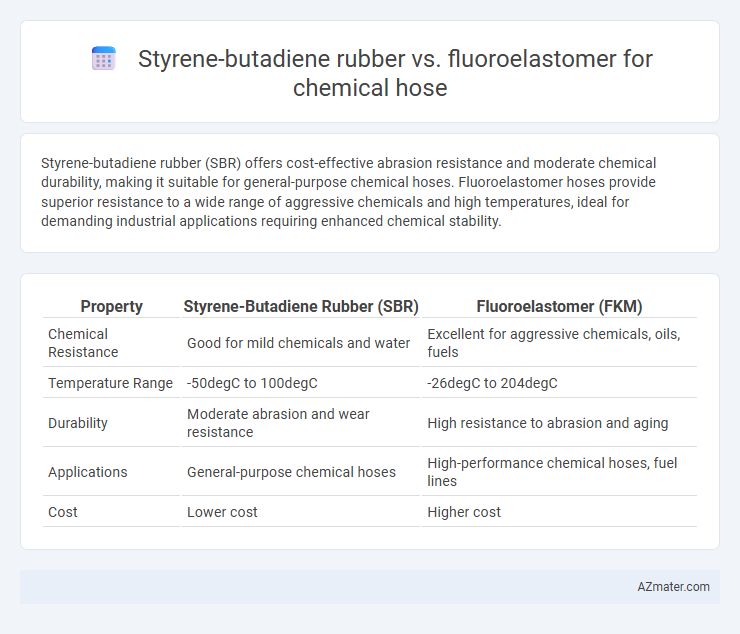Styrene-butadiene rubber (SBR) offers cost-effective abrasion resistance and moderate chemical durability, making it suitable for general-purpose chemical hoses. Fluoroelastomer hoses provide superior resistance to a wide range of aggressive chemicals and high temperatures, ideal for demanding industrial applications requiring enhanced chemical stability.
Table of Comparison
| Property | Styrene-Butadiene Rubber (SBR) | Fluoroelastomer (FKM) |
|---|---|---|
| Chemical Resistance | Good for mild chemicals and water | Excellent for aggressive chemicals, oils, fuels |
| Temperature Range | -50degC to 100degC | -26degC to 204degC |
| Durability | Moderate abrasion and wear resistance | High resistance to abrasion and aging |
| Applications | General-purpose chemical hoses | High-performance chemical hoses, fuel lines |
| Cost | Lower cost | Higher cost |
Introduction to Chemical Hose Materials
Styrene-butadiene rubber (SBR) and fluoroelastomer are key materials in chemical hose manufacturing, each offering distinct chemical resistance and durability profiles. SBR provides cost-effective abrasion resistance and flexibility but has limited resistance to oils, fuels, and solvents compared to fluoroelastomer, which excels in high-temperature environments and aggressive chemical exposure. Selecting the appropriate material depends on the specific chemical agents encountered, temperature ranges, and mechanical stress requirements to ensure hose longevity and safety.
Overview of Styrene-Butadiene Rubber (SBR)
Styrene-butadiene rubber (SBR) is a synthetic rubber commonly used in chemical hoses due to its excellent abrasion resistance, good aging stability, and cost-effectiveness. Its copolymer composition of styrene and butadiene provides moderate chemical resistance, making it suitable for transporting water-based chemicals and oils but less effective against strong acids or solvents. SBR offers flexibility and durability under various temperature ranges, though it generally has lower resistance to heat and certain chemicals compared to fluoroelastomers.
Overview of Fluoroelastomer (FKM)
Fluoroelastomer (FKM) offers superior chemical resistance, thermal stability up to 200-250degC, and excellent durability compared to styrene-butadiene rubber (SBR), making it ideal for chemical hose applications involving aggressive chemicals and high-temperature fluids. Its molecular structure provides exceptional resistance to hydrocarbons, oils, acids, and oxidizing agents, ensuring longer service life and reduced maintenance. These properties position FKM as the preferred choice in industries requiring premium performance and safety in harsh chemical environments.
Chemical Resistance Comparison
Styrene-butadiene rubber (SBR) offers moderate chemical resistance, primarily suitable for non-polar solvents, dilute acids, and alkalis, but it degrades quickly when exposed to hydrocarbons, oils, and strong oxidizers. Fluoroelastomers (FKM), such as Viton(r), exhibit superior chemical resistance, maintaining durability and elasticity when exposed to harsh chemicals including fuels, oils, solvents, acids, and ozone. For chemical hose applications demanding high resistance to aggressive substances and extreme environments, fluoroelastomers significantly outperform styrene-butadiene rubber in terms of longevity and performance reliability.
Temperature Tolerance
Styrene-butadiene rubber (SBR) typically withstands temperatures up to 70degC (158degF), making it suitable for general chemical hose applications with moderate heat exposure. Fluoroelastomer (FKM) exhibits superior temperature tolerance, maintaining performance in continuous use up to 200degC (392degF) and short-term exposure up to 250degC (482degF). This high thermal resistance enables fluoroelastomer hoses to handle aggressive chemicals and extreme temperature environments far beyond the capacity of SBR.
Mechanical Properties and Durability
Styrene-butadiene rubber (SBR) offers excellent abrasion resistance and good tensile strength, making it suitable for flexible chemical hoses subjected to mechanical stress and moderate temperatures. Fluoroelastomer (FKM) provides superior chemical resistance, high-temperature stability up to 200-250degC, and exceptional durability in harsh chemical environments, outperforming SBR in longevity and resistance to oils, fuels, and solvents. For applications requiring enhanced mechanical properties combined with chemical resistance, fluoroelastomer hoses deliver extended service life and reliability compared to standard SBR hoses.
Flexibility and Handling
Styrene-butadiene rubber (SBR) offers excellent flexibility and ease of handling in chemical hoses, making it suitable for applications requiring frequent movement and bending. Fluoroelastomer (FKM) provides superior chemical resistance but is generally stiffer, which can limit flexibility and handling compared to SBR. The choice between SBR and FKM hinges on balancing the need for flexibility with the specific chemical exposure and operational conditions of the hose.
Cost and Economic Considerations
Styrene-butadiene rubber (SBR) offers a cost-effective solution for chemical hoses due to its lower production expenses and widespread availability, making it suitable for applications with moderate chemical exposure. Fluoroelastomer hoses exhibit higher initial costs driven by advanced polymer chemistry and superior chemical resistance, which ensures longer service life and reduced replacement frequency in harsh environments. Evaluating total ownership cost reveals that fluoroelastomers provide economic advantages in aggressive chemical settings despite their premium price, whereas SBR remains economically favorable for less demanding applications.
Applications in Chemical Transfer
Styrene-butadiene rubber (SBR) offers excellent resistance to abrasion and is suitable for transferring non-aggressive chemicals and water-based solutions in chemical hose applications. Fluoroelastomers (FKM), such as Viton, provide superior chemical resistance against fuels, oils, solvents, and aggressive acids, making them ideal for harsh chemical transfer environments. The choice between SBR and fluoroelastomer depends on the chemical compatibility requirements and operating temperature range, with fluoroelastomers offering wider chemical resistance and higher thermal stability.
Choosing the Right Material for Chemical Hoses
Styrene-butadiene rubber (SBR) offers excellent abrasion resistance and cost-effective durability for chemical hoses used in general industrial applications but has limited chemical resistance to oils and solvents. Fluoroelastomers (FKM) provide superior chemical resistance, thermal stability up to 200degC, and resistance to aggressive fuels, acids, and hydrocarbons, making them ideal for hoses exposed to harsh chemicals and extreme environments. Selecting the right material depends on the specific chemical compatibility, temperature range, and mechanical requirements of the application to ensure optimal hose performance and longevity.

Infographic: Styrene-butadiene rubber vs Fluoroelastomer for Chemical hose
 azmater.com
azmater.com